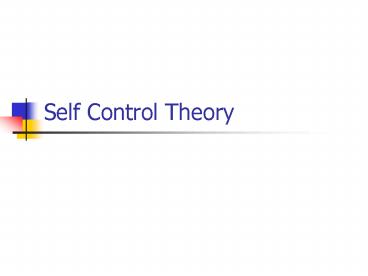Self Control Theory - PowerPoint PPT Presentation
1 / 15
Title:
Self Control Theory
Description:
Self Control Theory Self-control theory Hirschi collaborated with Gottfredson (1990) to develop the theory with the only one type of control self-control They did ... – PowerPoint PPT presentation
Number of Views:336
Avg rating:3.0/5.0
Title: Self Control Theory
1
Self Control Theory
2
Self-control theory
- Hirschi collaborated with Gottfredson (1990) to
develop the theory with the only one type of
control self-control - They did not clarify how their self-control
theory relates to Hirschis social bonding theory
- We can assume that all four elements of social
bonding must be an indicators of the concept of
self-control
3
Self-control theory
- Theory states that individuals with high
self-control will be less likely at all periods
of life to engage in criminal acts, while
individuals with low self-control are likely to
commit crimes
4
Elements of low self-control
- Self-control consists of the ability to delay
gratification - People with low self-control have a here and
now orientation and are unable or unwilling to
delay gratification. - Crime provides easy gratification of desires
(money without work, sex without courtship,
revenge without court delays) - People lacking self-control also tend to lack
persistence in a course of action
5
Elements of low self-control
- Criminal acts are exciting, risky, and thrilling
- They involve steal, speed, agility, deception,
and power - People lacking self-control tend to be
adventuresome, active, and physical - Those with high levels of self-control tend to be
cautious, cognitive, and verbal
6
Elements of low self-control
- Crimes provide a few long-term benefits
- They are not equivalent to a job or a carrier (on
contrary, crimes interfere with long-term
commitments to job, family, or friends) - People with low self-control tend to have
unstable marriages, friendships, and job profiles
7
Elements of low self-control
- Crimes require little skill or planning (the
cognitive requirements for most crimes are
minimal) - People lacking self-control need not possess or
value cognitive or academic skills
8
Elements of low self-control
- Crimes often result in pain or discomfort for the
victim - It follows that people with low self-control tend
to be self-centered, indifferent, or insensitive
to the suffering and needs of others
9
Elements of low self-control
- Low self-control argument rests on the idea that
crime is like any other reckless act. - Those with low self-control tend to smoke, drink,
use drugs, gamble, have children out of wedlock,
and engage in illicit sex - In addition, because low self-control is
associated with all types of crime, offenders
will tend not to specialize in particular kind of
crime.
10
Determinants of Low Self-Control
- Low self-control is produced in families where
there is little attachment between parent and
child, in families where parents fail to
recognize deviant behavior (for example, in cases
where parents are also deviant), or when parents
recognize deviant behavior and fail to correct it - Self-control that is not attainment in childhood
is unlikely to be produced in adulthood
11
Self-control
- Self-control develops during early socialization
- Once formed in childhood, the amount of
self-control remain relatively stable throughout
life - Parents who are attached to children, supervise,
monitor and punish deviant acts (family is the
most important agent) - Peer groups are relatively unimportant in the
development of self-control
12
Crime Rate Variations?
- Why do people commit less crime as they age?
- Why are some regions are more crime prone than
others? - Why are some groups are more crime prone than
others? - Does that mean there are between-group
differences in self-control?
13
Age-crime relationship
8-9 years
15-24 years
45-55 years
14
Answer of the theory
- Criminal propensity and criminal acts are
separate concepts - Crime is rational and predictable- people commit
crime when it promises rewards with minimal
threat of pain - If targets are guarded, crime rates diminish
- Only the truly irrational offender would dare to
strike under those circumstances
15
Answer of the theory
- Criminal offenders are people predisposed to
commit crimes, they are not robots who commit
crime without restrain - Their days are filled also with conventional
behaviors (school, church, job) - But given the same set of criminal opportunities
(free time, living in a neighborhood with
unguarded homes, etc) crime prone people are more
likely to violate the law.

